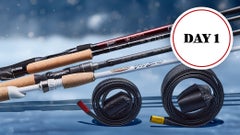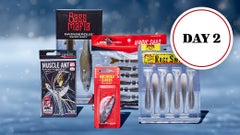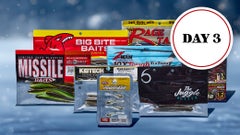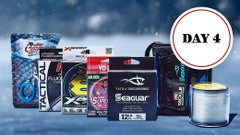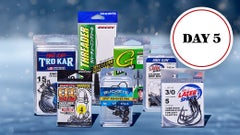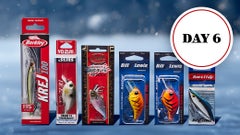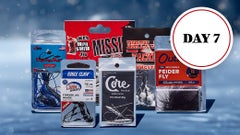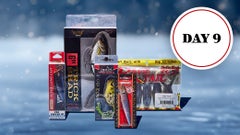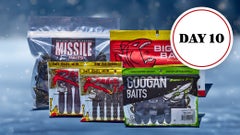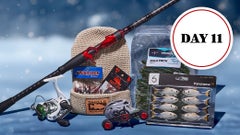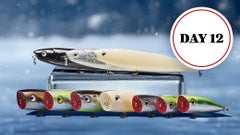Ray Hanselman Wins Ohio River Rayovac Championship
Ryan Hanselman Wins Ohio River Rayovac Championship
Out of the 152 pros who weighed in a fish, there were five stringers that weighed in excess of 15 pounds. Hanselman caught two of them. Third-place finisher Trevor Fitzgerald also had two 15-plus pound bags, but Hanselman's umbrella-rig pattern produced more consistent quality fish than anything else being thrown or dragged around the Ohio, Cumberland and Tennessee rivers. When asked to put his incredible streak into perspective, Hanselman humbly said he got a little bit lucky, but added all of his on-the-water experience - he guides for 200 days a year at Lake Amistad - came in handy at several points during the year. "Every lake just fell into my strengths," he said. "I grew up fishing lakes in south Texas with big fish and that's what I target. They just all set up perfect for me." At Amistad in February, he rode a swimbait pattern to victory. Then at Sam Rayburn, he flipped big fish out of the bushes. To cap it off, he put his experience with drastic rises in water to use at Lake Texoma to pick off fish that were moving into shallow water. "At the Ohio River, all I heard was how 12 pounds a day was going to win," he said, "but I'm always trying to see if there are big ones. At every lake I go to, I always tie on a big topwater or a big swimbait to see what I can find. A week either way at any of those lakes and maybe it goes in a different direction. "I had some success over the last 3 to 4 years catching a big bag on days 1 or 2 and then I'd flake out and panic and fall on my butt," he said. "I fished my strengths and stayed confident, which is a lot of what I've worked on the last couple years - just finishing the game and not getting rattled. My mindset now is all I need is five (bites). I've fine-tuned my practice to where if I can get five good bites a day or at least two or three of them, I'll feel pretty good going into a tournament."
Hanselman's preparation - the pre-practice trip and the practice session that immediately preceded the tournament - centered around locating bigger fish, smallmouth in this case, and it didn't him that long to draw upon his experiences in south Texas as a way to help dial in an effective pattern. "After I realized there were big ones in there, I was like, 'I've caught big smallies before behind a dam,'" he said, noting there are beefy smallmouth in the tailwaters behind the Amistad Dam. "If you get those fish fired up, you can pretty much catch them on a spark plug. Those are wolf pack fish and if you trigger one, you can get them all fired up. Those are the kind of fish I like looking for." His spent the early part of his first practice day in the same area where he'd had the followers on the swimbait, but there was an abundance of competitors around and he wanted to be careful about who saw what he was throwing if he started catching them. "I started with a jig until the others left," he said. "I told my co-angler to pick up the umbrella rig and within two casts, he caught a 5-pounder. I told him to put it up and we left (the area)." Hanselman went so far in his efforts to keep his curious competitors guessing that he'd open his rod lockers or have his co-angler sit down while he was unhooking the fish to make it seem like they were doing something other than getting a sample of what was there. "The next morning we did the same thing on a similar area," he said. "We caught a 5 and left. I told him, 'Either there are a bunch of them here or you made the two luckiest casts in the world.' I just didn't want to draw attention to myself." After that, he wanted to find some back-up areas where he felt he could fill out his limits with 2- and 3-pound fish. "I didn't know what was all there," he said, referring to his key area. "I didn't realize a bunch of big ones were there."
Competition:
He stayed off his "juice" areas to start day 1 of the tournament. He figured catching a limit of smaller fish would ease his nerves and make the hunt for bigger bites more palatable. By 9 a.m., he still only had one keeper so he made the move toward the dam. His second cast summed up his entire season. "On my first cast, I missed one," he said. "I threw back out and halfway back on the retrieve, it felt weird. I reeled it back toward the boat and I could see I had two fish on (the rig). They made a run under the boat and it got heavier and when they came back up, I told my co-angler to get the net out there ASAP. I had three fish on there." He put 9 pounds of fish in the boat on one cast and that set the stage for a 19-pound day that put him in 2nd place. Shortly after his memorable catch, another competitor pulled up and started making casts toward the same eddy Hanselman was fishing. Hanselman quickly stowed the umbrella rig rod and went back to the jig. After a barge obscured the view of the other boat, Hanselman made a couple more casts with the umbrella rig and caught a 5-pounder. "The other guy saw me net it, but I'm not sure he saw what I was throwing," he said. "That first day, I didn't make 20 casts with the rig and caught 19 pounds. I don't like being sneaky, but I don't know those people and I felt like I had to protect what I had."
He left his key area with around 3 hours of fishing time left and stopped on an area with some current by the launch ramp. He caught a 4-pounder on a jig and culled a smaller fish. He lost two other fish he figured were in the 4-pound class or bigger. "I could've had 23 or 24 pounds, but everybody loses them," he said. "I'm not complaining. You have to know that going in and not freak out." The current on his key stretch wasn't near as swift as it was on day 1 and the first two fish Hanselman caught on day 2 weren't near as big as what he'd been catching there. He changed areas and caught a 4 1/2-pounder, then added a 3 1/2-pounder, both on the umbrella rig, to get to four fish. "I then moved out into the main current and made a run back up the river," he said. "The fog was real bad that day. I made one pass where I'd started to get my fifth. I figured I had enough to make the (Top-10) cut. After that I ran back down river to kill time."
The 11-14 on day 2 was his smallest bag of the event, but it moved him into the lead entering the final day. By day 3, he'd narrowed his spot rotation down to three areas, but after two days of fishing in strong current with a wind that was blowing with the current, he needed to keep close tabs on his trolling motor batteries. "I was running them hard every day," he said. "I had it on 70 to 100 (power) just to hold my spot. I wasn't getting full charges every night and with a 20-mph wind on top of the current, it made it tough." He caught three pretty quick to start day 3, then stuck a 4-pounder before going a couple hours without a bite. His batteries were becoming an issue at that point and he started to panic a little. He finished his limit for 12 or 13 pounds with a 2 1/2-pounder, but he wasn't quite satisfied. "I wanted to have some cushion because I knew guys were on big ones," he said. "I went to some slack water for largemouths mainly to save my batteries, but after a while, I said, 'What are you doing? Go up there and do more drifts.'" He got his boat back into position in the current, made a long cast and got his rig down in the water column and a 5-pounder struck. "I knew that was it," he said. "I had tears streaming down my face behind my Costas after I caught that one. "It's hard to put in words. I could not believe that it just happened. It was a like a relief. All of those years of being close and letting things slip by and making the wrong adjustments - it all felt complete and like I'm done. I've accomplished what I wanted to do."
Winning Pattern:
Hanselman was targeting areas where the smallmouth could move out of the stronger current, but still be able to ambush baitfish as they meandered past. "They were slate rock rises with little jagged stuff on top," he said. "It was 14 feet on the up-current side and it would rise up to 8 or 9 feet, then drop to 14 and come up again on the other side. I used my Side Imaging to find those deals. The key was finding a couple in a row or close to each other where the fish could basically do a figure-8 back and forth." He said bluegill were a common baitfish in the area and there were plenty of Asian carp around as well, which is why he tried to match their coloring with his baits. "I snagged some there that were pretty small and I had a good feeling the bass were eating those," he said. "There weren't as many shad there as there would be in Kentucky Lake. There were more baby Asian carp and bluegill than anything."
Winning Gear:
Umbrella gear: 7'11" extra-heavy Power Tackle swimbait rod, Shimano Curado and Chronarch casting reels (6.5:1 gear ratio), 65-pound unnamed braided line and 17-pound unnamed fluorocarbon line, unnamed 5-wire umbrella rig (4 blades), 1/2- and 3/4-oz. Strike King Squadron swimbait heads, unnamed 3" swimbait (dummy heads), unnamed 4" swimbait, unnamed 5" swimbait (natural shad pattern). Hanselman rigged the 4" baits on the two bottom wires and put the 5" swimbait in the middle. He said the bigger bait caught the majority of the fish. "It had more of a lazy tail so maybe the fish were drawn to that," he said. One of his weigh-in fish came on a 3/8-oz. Strike King Denny Brauer Baby Structure Jig (blue craw) with a Strike King Rage Menace (Falcon Lake craw) trailer. "That's my go-to jig around structure," he added. His other weigh-in fish came on the big line-through swimbait. "I would've thrown the swimbait more, but it took me most of day 2 to get five keepers and it was the same day 3," he said. "If I'd have had five quicker, I would've picked it up sooner."
Main factor: "Learning how fish relate to current here at home and applying that. If I hadn't had done that, I'd have fished the backwater creeks and not had the confidence to fish that swift water."
Performance edge: "Surrounding yourself with the best stuff and taking out all the variables you can control. Having the best equipment is key. It all has to work."
Rayovac Championship Winning Pattern BassFan 11/3/15 (Todd Ceisner)
Brandon's Pattern, Baits & Gear
Despite losing a key fish each day that took him out of the running for the win, Perkins felt like he was always fishing for 2nd place. "I feel like it was Ray's to win," he said. "He's just on fire. He's the hottest fisherman on the planet and I feel like it was destiny for him. If I'd have kept the fish on, I could've given him a run for it." Perkins, who works full time for a hospice company, opted to skip the 3 days of official practice before the tournament. Instead, he put in time on the water during the weekend prior to competition. "I fished the bank some, but all I could catch were 12-inch spotted bass and drum," he said. "My strength is off shore so I realized I needed to get out there. Everybody was on the bank and I was out there scanning around. Everybody started looking at me." His best spot had a rock pile in 19 feet of water and cycled through a variety of baits before settling on a cranking pattern for the tournament. "I chose the crank because every time in practice I picked up a swim jig or swimbait or Carolina rig, it'd be a drum," he said. "I caught some of those on the crank, but not near as many because I was fishing it so fast." The snaggy features around where he was fishing claimed several dozen 6XD crankbaits during the tournament. He wound up with three left in his boat at the end of the week. The wind was out of the South on day 1 and that allowed him to make extra-long casts with the deep-diving plug. "It kept the bait in the strike zone for so long," he said.
He caught five keepers, had a 4 1/2-pounder jump off and wound up with 13-10, but he made a discovery later in the day that benefited him on day 2. "I'd already caught my limit off my good spot and I had no trolling motor battery left so I was drifting along some bank throwing a spinnerbait," he said. "I saw this crankbait randomly floating and I remember thinking that I figured I'd need some more. It was a chartreuse blueback 6XD so I tied it on and caught three fish the next day on that exact bait." A dense wall of fog in the morning kept him from running to his best spot right away so he stopped on a rocky shelf and caught two largemouth with a spinnerbait. When he eventually got to his best spot, the fish weren't ganged up liked they'd been. He left and came back four times throughout the day and when he returned around 1:30, he caught a 4 1/4-pounder and two others while another good one pulled off. He wound up with seven bites and weighed 13-11 to make the Top-10 cut in 5th place. For the second day in a row, the wind and current made it difficult to make effective lure presentations on his key stretch and his trolling motor batteries became a concern again. "I knew going into the last day it was an afternoon hole and I should've drifted with the current on my other stuff," he said. "By time I got to my hole, my trolling motor was drained. I caught a 4 1/4 and a 5 1/4 right away." Without his trolling motor at full capacity, he'd have to idle past his sweet spot, make two casts, then idle back up and star the process over again. "The problem was over the last 2 days, the wind was blowing with the current and my bait was only in the strike zone for 5 feet rather than 40 feet," he said. He managed to catch three on the final day that weighed 11-04.
Crankbait gear: 7'11" medium-heavy Hammer Rods casting rod, Abu Garcia Revo casting reel (6.4:1 gear ratio), 12-pound Berkley Trilene 100% fluorocarbon line or 10-pound Seaguar InvizX fluorocarbon line, Strike King 6XD (chartreuse blue back or citrus shad). Perkins upsized the stock hooks on the 6XD to 2/0 Owner 2X Stinger trebles. He also weighed in two fish caught on a Strike King Bottom Dweller spinnerbait.
Main factor: "Putting my time in scanning instead of fishing. I probably put 30 or 40 hours on my unit just idling and looking for stuff a little deeper than everybody else."
Performance edge: "I relied so much on my Lowrance HDS-12 units to find those rock piles more than anything."
Trevor Fitzgerald's Pattern, Baits & Gear
"I didn't fish a whole lot, but did a lot of graphing in the Cumberland and Tennessee rivers for isolated rock piles," he said. "I learned at the Alabama River (Southern Open) that it was the same deal. I was fishing isolated rock piles off the bank where those fish position behind current breaks." He felt like he had a good thing going in the Cumberland River in practice and that's where he headed for day 1. He had trolling motor issues early on, but the high, muddy water had the fish in negative mood and he stumbled in with one fish for 1-15. "I had one spot up there and I figured I could catch 10 pounds of spots and then get lucky and catch a 3- or 4-pound smallmouth," he said. "When that went away, I went to the Tennessee River and caught that little smallmouth." On Friday, he went to some rock piles in the Tennessee River and found the water to be clearer and the fishing much better. "I think a lot of it had to do with the water coming out of Kentucky Lake," he said. "There's a lot more grass in there and the water was just cleaner." He got dialed in on a swimbait and jig pattern around current breaks. "I started catching them pretty quick," he said. "In practice, the rock piles were exposed, but on day 2, they had parked six barges next to each other and they were parked on top of some of my piles." He adjusted jig sizes to a half-ounce version and would cast in front of the barges and let the current take it down. "If I didn't feel the rocks, that meant a fish had it," he said.
His 18-11 stringer marked a staggering turnaround from day 1 and earned him a spot among the 10 finalists. On the final day, four of the barges had moved out so he was able to fish the rock pile effectively. He caught more on a swimbait than he had been. "It was more action packed," he said, noting the rock pile was sitting in 12 feet of water. "I was catching them casting as opposed to dragging." He hauled in 17-08 on the final day to close the gap and capture 3rd. It was his fifth Top-10 finish of the year across the Rayovac Series and Bassmaster Opens. "Except for day 1, if I hadn't been so hardheaded and tried to make the Cumberland River work it could've been a different turn of events," he said. "I talked to Ray after it was over and neither of knew the potential of the spots we had. We were both blown away at how good our spots were."
Jig gear: 7'3" medium-heavy Fitzgerald Rods Stunner HD casting rod, 13 Fishing Concept A casting reel (7.1:1 gear ratio), 15-pound Seaguar InvizX fluorocarbon line, 1/2-oz. unnamed football jig (homemane peanut butter and jelly skirt), Zoom Fat Albert trailer (green-pumpkin).
Swimbait gear: Same rod, same reel, 17-pound Seaguar InvizX fluorocarbon line, 3/4-oz. Revenge swimbait head, 4.5" True Bass Little Head swimbait (turbo). Fitzgerald said he fished the swimbait like a crankbait. "I'd throw it out and let it sink, then reel it fast," he said. "They were reacting to it, especially if it hit a rock. I switched up the retrieve a little bit."
Main factor: "Finding the current breaks. In practice, they were not pulling much water, but after all that rain, the current basically tripled. Once they opened those gates, it helped my pattern when looking for current breaks."
Performance edge: "My Interstate batteries luckily held up all day long. I had my trolling motor on 80 all day every day and they held up. I was pretty impressed with that. My Skeeter FX20 and Yamaha didn't give me any problems either."










